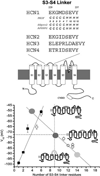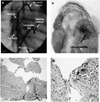Gene- and cell-based bio-artificial pacemaker: what basic and translational lessons have we learned?
- PMID: 22673497
- PMCID: PMC3375623
- DOI: 10.1038/gt.2012.33
Gene- and cell-based bio-artificial pacemaker: what basic and translational lessons have we learned?
Abstract
Normal rhythms originate in the sino-atrial node, a specialized cardiac tissue consisting of only a few thousands of nodal pacemaker cells. Malfunction of pacemaker cells due to diseases or aging leads to rhythm generation disorders (for example, bradycardias and sick-sinus syndrome (SSS)), which often necessitate the implantation of electronic pacemakers. Although effective, electronic devices are associated with such shortcomings as limited battery life, permanent implantation of leads, lead dislodging, the lack of autonomic responses and so on. Here, various gene- and cell-based approaches, with a particular emphasis placed on the use of pluripotent stem cells and the hyperpolarization-activated cyclic nucleotide-gated-encoded pacemaker gene family, that have been pursued in the past decade to reconstruct bio-artificial pacemakers as alternatives will be discussed in relation to the basic biological insights and translational regenerative potential.
Conflict of interest statement
The author declares no conflict of interest.
Figures




Similar articles
-
Bioartificial sinus node constructed via in vivo gene transfer of an engineered pacemaker HCN Channel reduces the dependence on electronic pacemaker in a sick-sinus syndrome model.Circulation. 2006 Sep 5;114(10):1000-11. doi: 10.1161/CIRCULATIONAHA.106.615385. Epub 2006 Aug 21. Circulation. 2006. PMID: 16923751
-
Gene Delivery for the Generation of Bioartificial Pacemaker.Methods Mol Biol. 2017;1521:293-306. doi: 10.1007/978-1-4939-6588-5_21. Methods Mol Biol. 2017. PMID: 27910058
-
Dynamic action potential clamp as a powerful tool in the development of a gene-based bio-pacemaker.Annu Int Conf IEEE Eng Med Biol Soc. 2008;2008:133-6. doi: 10.1109/IEMBS.2008.4649108. Annu Int Conf IEEE Eng Med Biol Soc. 2008. PMID: 19162611
-
Cell-based Biological Pacemakers: Progress and Problems.Acta Med Okayama. 2018 Feb;72(1):1-7. doi: 10.18926/AMO/55656. Acta Med Okayama. 2018. PMID: 29463932 Review.
-
Biological pacemakers as a therapy for cardiac arrhythmias.Curr Opin Cardiol. 2008 Jan;23(1):46-54. doi: 10.1097/HCO.0b013e3282f30416. Curr Opin Cardiol. 2008. PMID: 18281827 Review.
Cited by
-
Tachycardia-bradycardia syndrome: Electrophysiological mechanisms and future therapeutic approaches (Review).Int J Mol Med. 2017 Mar;39(3):519-526. doi: 10.3892/ijmm.2017.2877. Epub 2017 Feb 6. Int J Mol Med. 2017. PMID: 28204831 Free PMC article. Review.
-
Enrichment differentiation of human induced pluripotent stem cells into sinoatrial node-like cells by combined modulation of BMP, FGF, and RA signaling pathways.Stem Cell Res Ther. 2020 Jul 16;11(1):284. doi: 10.1186/s13287-020-01794-5. Stem Cell Res Ther. 2020. PMID: 32678003 Free PMC article.
-
Bioengineering the Cardiac Conduction System: Advances in Cellular, Gene, and Tissue Engineering for Heart Rhythm Regeneration.Front Bioeng Biotechnol. 2021 Aug 2;9:673477. doi: 10.3389/fbioe.2021.673477. eCollection 2021. Front Bioeng Biotechnol. 2021. PMID: 34409019 Free PMC article. Review.
-
Chemically defined and small molecules-based generation of sinoatrial node-like cells.Stem Cell Res Ther. 2022 Apr 11;13(1):158. doi: 10.1186/s13287-022-02834-y. Stem Cell Res Ther. 2022. PMID: 35410454 Free PMC article.
-
Hyperpolarization-activated current, If, in mathematical models of rabbit sinoatrial node pacemaker cells.Biomed Res Int. 2013;2013:872454. doi: 10.1155/2013/872454. Epub 2013 Jul 8. Biomed Res Int. 2013. PMID: 23936852 Free PMC article. Review.
References
-
- Boyett MR, Honjo H, Kodama I. The sinoatrial node, a heterogeneous pacemaker structure. Cardiovasc Res. 2000;47:658–687. - PubMed
-
- Dobrzynski H, Boyett MR, Anderson RH. New insights into pacemaker activity: promoting understanding of sick sinus syndrome. Circulation. 2007;115:1921–1932. - PubMed
-
- Boyett MR, Dobrzynski H, Lancaster MK, Jones SA, Honjo H, Kodama I. Sophisticated architecture is required for the sinoatrial node to perform its normal pacemaker function. J Cardiovasc Electrophysiol. 2003;14:104–106. - PubMed
-
- Boyett MR, Honjo H, Yamamoto M, Nikmaram MR, Niwa R, Kodama I. Downward gradient in action potential duration along conduction path in and around the sinoatrial node. Am J Physiol. 1999;276:H686–H698. - PubMed
-
- Boyett MR, Honjo H, Yamamoto M, Nikmaram MR, Niwa R, Kodama I. Regional differences in effects of 4-aminopyridine within the sinoatrial node. Am J Physiol. 1998;275:H1158–H1168. - PubMed
Publication types
MeSH terms
Substances
Grants and funding
LinkOut - more resources
Full Text Sources
Other Literature Sources
Medical
Miscellaneous

